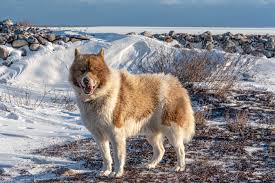
Canadian Eskimo Dog
Conditions of detention
Canadian Eskimo Dogs are best suited for cold climates and rural or suburban environments where they have plenty of space to roam and work. They do not adapt well to hot climates or small living spaces.
Useful Fact: These dogs thrive in environments where they can perform physical tasks and have regular access to the outdoors, reflecting their working dog nature.
Nutrition and diet
A balanced diet rich in high-quality proteins, fats, and essential nutrients is crucial for the Canadian Eskimo Dog. Their diet should support their high energy levels and robust physique.
Useful Fact: Due to their high activity levels, these dogs may benefit from a diet formulated for working or high-energy breeds, ensuring they get the necessary nutrients to maintain their stamina and overall health.
Health
Canadian Eskimo Dogs are generally healthy but can be prone to certain hereditary health issues such as hip dysplasia and arthritis. Cold-related injuries are also a concern if they are kept in unsuitable climates.
Useful Fact: Regular veterinary check-ups and maintaining an appropriate diet and exercise regimen can help prevent and manage health issues common in the breed.
Grooming and care
The Canadian Eskimo Dog has a thick double coat that can be medium to long in length, providing insulation against harsh Arctic conditions. Coat colors can vary, including white, black, grey, and red.
Useful Fact: Regular brushing is essential to manage shedding and keep their coat healthy. During seasonal shedding periods, more frequent grooming is necessary to handle the increased hair loss.
Education and training
Canadian Eskimo Dogs are intelligent and have a strong work ethic, but they can also be independent and sometimes stubborn. Positive reinforcement and consistent training methods are effective.
Useful Fact: Early socialization and obedience training are crucial to ensure they develop good manners and adapt well to various environments and situations.
Toys and entertainment
These dogs enjoy toys that challenge their intelligence and physical abilities. Durable chew toys, interactive toys, and activities like pulling sleds or carts are ideal.
Useful Fact: Providing them with tasks that mimic their traditional work, such as pulling weight or participating in agility exercises, can keep them mentally and physically engaged.
Safety
Given their strong drive and endurance, it is important to supervise Canadian Eskimo Dogs during outdoor activities and ensure they are in a secure area to prevent them from wandering off.
Useful Fact: Secure fencing and a well-supervised environment are essential to keep them safe, especially given their strong instinct to explore and work.
Accessories
Sturdy collars, leashes, and harnesses designed for large and strong dogs are suitable for Canadian Eskimo Dogs. Comfortable bedding and durable toys are also recommended.
Useful Fact: Using a harness during walks can provide better control and prevent strain on their neck, which is especially important given their strength and tendency to pull.
Socialization
Early socialization helps Canadian Eskimo Dogs become well-rounded and confident. Exposing them to different environments, people, and other animals is key.
Useful Fact: Positive socialization experiences can help manage their natural protective instincts and ensure they are comfortable in various settings.
Travel and Transportation
Canadian Eskimo Dogs can be good travelers if acclimated to it early. Using a secure and comfortable crate or carrier during transportation ensures their safety and reduces stress.
Useful Fact: Regular breaks during long journeys help them stay comfortable and hydrated, reducing travel-related anxiety.
Behavior and psychology
The Canadian Eskimo Dog is known for being loyal, hardworking, and intelligent. They form strong bonds with their family and can be protective. Understanding their need for mental and physical stimulation is important.
Useful Fact: Providing them with tasks or jobs can help satisfy their working dog instincts and keep them mentally engaged.
Legal aspects
Ownership regulations for Canadian Eskimo Dogs may vary by region. Adherence to local laws regarding pet registration, vaccinations, and leash laws is important.
Useful Fact: Keeping updated identification and health records helps ensure compliance with legal requirements and safeguards their wellbeing.




